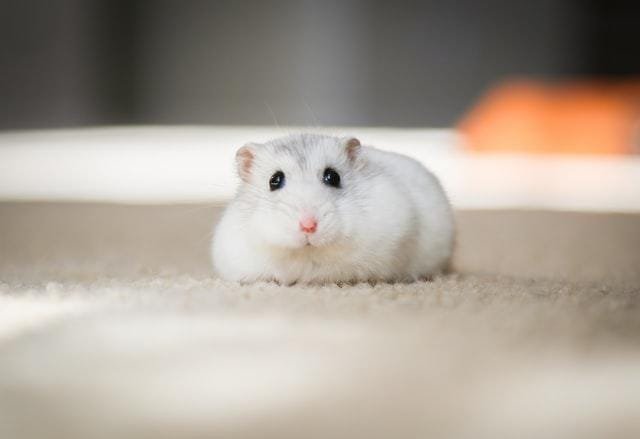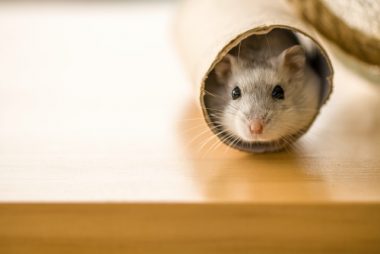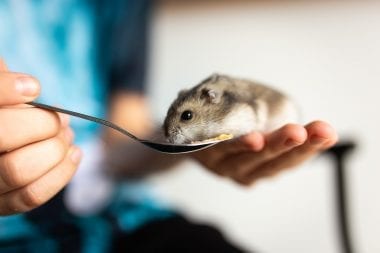Hamsters are relatively calm pets that are not noted for being noisy. But as any hamster parent would inform anyone, these tiny creatures can make a variety of vocalizations. There seem to be a variety of reasons for these vocalizations, and as a hamster owner, it’s a good idea to become familiar with them.
Although many noises are not widely examined and might be interpreted in multiple ways based on the circumstances, learning these noises can help you better understand your hamster and attend to their demands. When it comes to hamster noises, context is crucial, and understanding the associated body language will go a long way toward figuring out what your hamster is trying to say.
We will examine the eight most frequent hamster noises and what they mostly indicate in this post.
1) Squeaking:
It is a noise your hamster may make on a regular basis. Depending on the scenario, it may be either good or bad. What seems to be evident is that the hamster is having a strong reaction to something. And, its opinion is highly important and deserves attention.
When hamsters sleep, they do this. In the midst of his slumber, they begin to creak. In terms of noise, it’s similar to a rubber duck. A little, irritated stuffed animal. They appear to have been offended and are too stunned to respond with anything more than a hmph.
Other rodents do this while they’re discovering their environment, obtaining food item, smelling something new, and so on. It is a powerful response, but it’s not necessarily positive or negative.
2) Bruxing:
Hamsters make a clicking sound when they rub their teeth together, a behavior known as “bruxing.” This sound, comparable to a purring cat, is typically an indication of a comfortable and happy hamster! When you hear your hamster’s teeth snapping, you may relax knowing that everything is OK in their world!
3) Clicking by teeth:
When hamsters are upset or irritated, they will click their teeth. Just like, their having to click is so twitchy and frantic that handling them is impossible. Hamsters also will click their teeth at one another to indicate that they should avert their eyes. They are used to click their teeth every so often and take them out on the cage bars.
Stay away from your hamster if he is clicking his teeth at you. Allow him some room and return after he has quieted down and stabilized.
But if he is snapping his teeth even when you are not around, he is not upset at anyone. He is just anxious and, once more, should not be touched because he won’t remain still.
Once they are like that, it is never a good indication, and they are anxious.
4) Crying or Hissing:
It is something I sincerely hope nobody ever has to hear. It is never a pleasant sound, and it will rip you apart. The hamster sounds like a scream, but with the mouth shut. This sound is only made by hamsters when they are extremely agitated, agitated, or in agony.
It is a sound you could hear if you are pursuing a young, new hamster in your room because you dropped him. He’s not thrilled about being pursued, and he’s surprised and angered.
When your Dwarf partners start fighting, you will hear this sound as well. It may not be particularly intense at times, but it may occur.
5) Cooing:
Hamster cooing has been reported by many hamster owners. It is a gentle, vibrating sound. They are not necessarily afraid or furious, but it is a sound they make when they are happy.
But not many people have heard this noise. I have included it here in case your hamster makes it. It is reassuring to know your hamster may not be the only oddball.
6) Chirping:
Hamsters, like birds, make chirping noises. They normally make this noise for much the same purpose they squeak. They may be joyful and pleased, or they may be afraid or angry. But, the context is crucial in determining the cause.
7) Sneezing:
Hamsters, like human beings, may cough and sneeze in response to anything in their surroundings. They may respond to some dust or an unpleasant odor with a little coughs and sneezes fit, but this is typically nothing to be concerned about.
However, some hamsters will sneeze or cough owing to sensitivities, or they may have a viral infection. And if they are sneezing excessively, they should be sent to the veterinarian for an examination.
8) Screaming:
Nobody wants to hear a sobbing or screaming hamster, particularly not the hamster’s parent! To say the least, it is a disconcerting sound that will pierce your heart and soul. Shrieking is also uncommon in hamsters. They normally only do so when they are highly disturbed, terrified, or in pain.
A distressed hamster, one that has been thrown or is in agony. Two warring rodents will yell or cry from time to time, and it is not a nice sound!
How to understand the body language of your hamster?

Your hamster’s behavior might reveal a lot about how they are feeling. The majority probably, your hamster’s behavior is quite normal (even if it seems unusual at first!). However, you should become more familiar with their regular behaviors and body language so you can recognize when something just is not right.
1) Grooming:
Grooming is a crucial behavior for your hamster, and if they groom on a regular basis, it’s typically an indication that they’re happy in their surroundings.
2) Yawning and stretching:
It is usually an indication that your rodent is at ease and secure with you or in their surroundings.
3) Biting the bars of their cage:
You may notice that your hamster bites the railings of its cage occasionally. It is assumed that this behavior is driven by a need for admiration. So if your hamster enjoys playing outside, make sure they have quite enough toys to keep them occupied.
4) Standing upon its rear legs:
This is what hamsters do when they are inquisitive about something else and want to hear everything out. They can also lock in this posture for up to two minutes at least.
This is something hamsters do frequently because, in the wild, they’d have to do it every few minutes to watch for attackers.
This is typical hamster activity, and the hamster is not afraid.
5) Biting and nibbling:
Sometimes hamsters bite, especially if you surprise or frighten them. They also may nibble, indicating because they’ve had their fill of being stroked.
6) Daytime sleeping:
Hamsters are active at night, meaning they sleep during the day and are mainly nocturnal. It is entirely natural, so don’t bother your pet throughout the day.
7) Hibernation:
Hamsters often hibernate in the wild. The light and warmth of our houses try to suppress this inclination. Nevertheless, some domestic hamsters may even do so if the environment is too chilly. If your hamster appears to be sleeping, transport it to a warmer place and keep an eye on it. If it does not appear to wake up, get veterinarian help.
8) Mouth open and ruffled fur:
The hamster is trying to threaten and is preparing to fight.
Once that happens, go down to the hamster’s eye level. Your complete body, not only your head. Hamsters are threatened by things larger than themselves. Thus, aim to shrink as much as possible. Softly speak to him till he relaxes. To help things along, offer him a reward.
9) Rubbing its belly against some object:
It is merely a hamster establishing his domain. Dwarf hamsters have a smell gland on their abdomen, whereas Syrian hamsters have one on each hip.
When the hamster feels something is his, he will mark it with his scent gland.
Speak to your veterinarian if you have any questions or fears regarding your hamster’s behavior. They will be able to tell you if there are any issues or improvements you should do to make your rodent remain calm.
Should you pet a hamster?
It might be tempting to buy a hamster on the spur of the moment. After all, these adorable little creatures are little, spherical, fuzzy, and curious. Isn’t this a terrific first pet? Not in the least! Here are some key questions to think about before jumping into a commitment.
1) Commitment:
A hamster’s typical lifetime is 2.5 to 3 years, with modest differences across species. This trait may appeal to you if you are unable to commit to a pet for an extended period. However, if you have small children and aren’t ready for them to see the demise of a pet, a longer-lived animal may be preferable.
2) Time:
Hamsters are quite self-sufficient. They can keep themselves entertained for long periods if their environment is appropriately supplemented with toys, padding, and tunneling and jumping chances. Your hamster should still be handled and interacted with regularly to be happy and well-adjusted. Please remember that you will need to cleanse your hamster’s cage completely once a week.
3) Space Constraint:
Syrian hamsters are lonely, territorial creatures who require their living environment. If hamsters are housed together, they will fight and inflict significant harm on one another, therefore they must each have their place. Allowing hamsters to reproduce is not suggested.
4) The health of the parent:
Salmonella, an intestinal bacterium that causes short but severe bouts of illness in healthy individuals, can be carried by hamsters. If a pregnant mother passes it on to her unborn child, though, it might cause far more serious complications. Salmonella can also cause significant illness in people who are already unwell from other illnesses.
Lymphocytic choriomeningitis is a virus that has been found in hamsters. This virus causes flu-like symptoms or no symptoms at all in healthy persons. It may, however, be passed from a pregnant mother to her unborn child and can cause serious sickness in persons who have weakened immune function.
5) Children:
Hamsters are commonly acquired as pets for youngsters who wish to play with them during the day due to their tiny size. However, just as your youngster is about to fall asleep, a hamster is about to awaken. A hamster that has been awoken from a daytime snooze may bite. As a result, children under the age of eight should only handle hamsters under adult supervision.
Because of their immature immune systems and their proclivity for intimate contact with pets without adequate handwashing. Young children are more susceptible to zoonotic illnesses (diseases that may be transmitted from animals to humans). Salmonella, a kind of intestinal bacterium that hamsters can carry, is especially dangerous to children under the age of five.
Learning to recognize the various noises your hamster makes is an important part of getting to know them better and will help you better satisfy their needs. Remember that the context of the sounds they are producing is vital, especially when they are squeaking. So it is up to you to figure out if they are excited or afraid!








